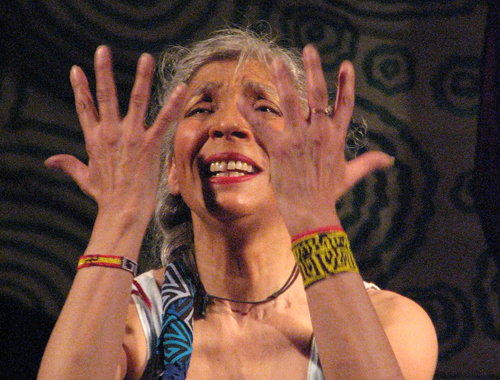
We think of plays as being based on stories, but there may be other sources for theatre. Can pictographs used in textile art created by the Kuna people of Panama form the basis for a play? What about the effigies and burial mounds used by other indigenous cultures?
U of G theatre professor Ric Knowles believes these and other approaches can be translated into theatre and, in the process, new understanding between indigenous and non-indigenous people can be forged.
He’s recently received funding to carry out this research, through a research creation grant program offered for the last time this year by the Social Sciences and Humanities Research Council. That timing makes Knowles even happier to have received a three-year grant for a project entitled Indigenous Knowledge, Contemporary Performances. It’s also impressive that this project was ranked second nationally among all the applicants.
“I’m the principle investigator with six others from various parts of North America,” explains Knowles, who has studied native Canadian theatre for many years. “I will be mapping three different research projects across three different performances.”
The first play, Chocolate Woman Dreams the Milky Way, has already been performed in Toronto, where it garnered a four-star review in Now magazine. The play will now go on tour to other locations in Canada, the United States and Panama. The play was inspired by pictographs on “molas,” pieces of textile art worn on the clothes of Kuna women living in the Kuna Yala area of coastal Panama, and was performed by Monique Mojica, a Kuna and Rappahannock actor and playwright based in Toronto.
The next two plays will be Omushkego Cree Water Stories, which will use shadow puppets and other Cree storytelling techniques, and Circus Freaks and Sideshow Injuns, which will take inspiration from effigies and burial mounds.
Knowles outlines three research goals. The first is to abstract ways that other indigenous groups could use their storytelling traditions or their understanding the world to create contemporary performances. The second involves developing new dramaturgical forms or structures to communicate indigenous knowledge; in other words, finding ways to adapt more traditional play structure so that it better reflects the indigenous culture. Third, Knowles hopes to develop methods for writing scripts that go beyond words to include movements and other aspects that are important to these productions.
During the development of Chocolate Woman, Mojica began by improvising the performance of a few stories, based on the extensive research done by the group. Then she recorded what she had done using pictographs on nine-foot-long strips of paper. Kuna pictographs run from left to right, then right to left, then left to right again, snaking back and forth on the page, and Mojica followed this pattern. By laying the strips of paper on the floor, she was able to use them as a script for her performance.
“We now have someone working with Monique to develop these as mnemonic devices and a script for actors. They are a combination of the traditional Kuna pictographs and what an actor needs as a cue for actions,” says Knowles.
He adds that final scripts for the three productions will look quite different. “The Omushkego Cree don’t use pictographs,” he explains, “so we will take another approach for the script to that play.”

Knowles says he feels it a privilege to be involved in this work as a non-native. “Most of my work as a dramaturge is intercultural,” he says. A dramaturge helps a playwright find the right structure and approach to a play and protects that structure once the play is in rehearsal and being performed.
Finding that structure can take a lot of research. For example, Knowles says, “Everything in Kuna culture is in twos; even their houses are built as two houses together. Western plays are generally put together in threes, with a beginning, middle and end.” During the creation of Chocolate Woman, Knowles helped to weave in this concept of twoness and parallels. And unlike most traditional plays, the emphasis in Mojica’s performance is not conflict but contrast.
A delegation of Kuna people came up from Panama to see the Toronto production, and Knowles looks forward to taking it to their country, where it will reach a larger audience. The play was performed in English and Kuna in Toronto, but will be done in Spanish and Kuna for the Panamanian audiences.
Knowles is enthusiastic about the research process he’s involved in, comparing it to the process of scientific exploration. “The rehearsal hall and the theatre stage are the laboratories where we do our research and make our discoveries,” he says. What he hopes is that these discoveries will help indigenous communities find new ways to share their cultures and their stories.